Yamaha SX210, SR210, AR210 Manual
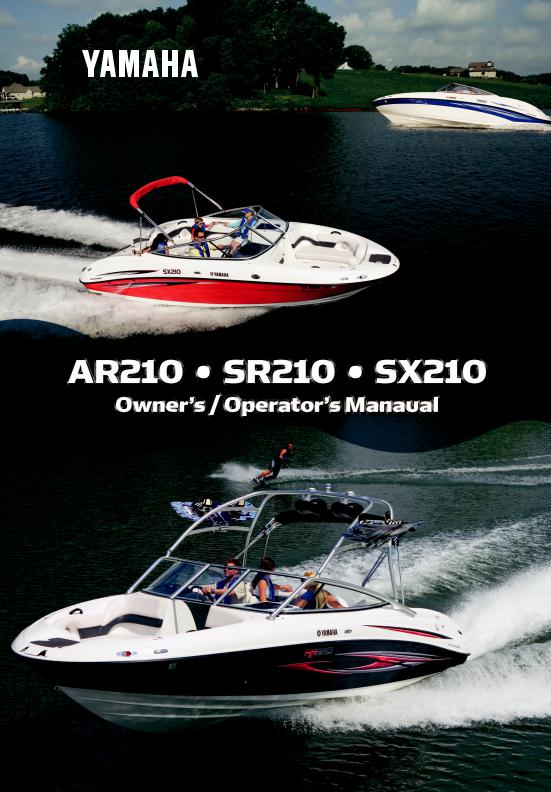
READ THIS MANUAL
CAREFULLY BEFORE OPERATION!

 WARNING
WARNING
The engine exhaust from this product contains chemicals known to the State of California to cause cancer, birth defects or other reproductive harm.
YAMAHA |
LIT-CALIF-65-01 |

TO THE OWNER
Thank you for choosing a Yamaha Boat. This Owner’s Manual contains information you will need for proper operation, maintenance, and care. A thorough understanding of these simple instructions will help you to obtain maximum enjoyment from your new Yamaha. If you have any questions about the operation or maintenance of your boat, please consult a Yamaha dealer.
Because Yamaha has a policy of continuing product improvement, this product may not be exactly as described in this Owner’s Manual. Specifications are subject to change without notice.
This manual should be considered a permanent part of this boat and should remain with it even if the boat is subsequently sold.
IMPORTANT MANUAL INFORMATION:
In this manual, information of particular importance is distinguished in the following ways:
The Safety Alert Symbol means
ATTENTION! BECOME ALERT!
YOUR SAFETY IS INVOLVED!
 WARNING
WARNING
Failure to follow WARNING instructions could result in severe injury or death to the machine operator, a bystander, or a person inspecting or repairing the boat.
CAUTION:
A CAUTION indicates special precautions that must be taken to avoid damage to the boat.
NOTE: A NOTE provides key information to make procedures easier or clearer.
AR210 (FRT1100C-F)
SR210 (FRT1100-F), SX210 (FRT1100A-F/FRT1100B-F),
OWNER’S/OPERATOR’S MANUAL
© 2006 by Yamaha Motor Corporation, USA 1st Edition, June 2006
All rights reserved. Any reprinting or unauthorized use
without the written permission of Yamaha Motor Corporation, USA is expressly prohibited. Printed in USA
LIT-18626-07-19
06-331

AR210, SR210, SX210
SAFETY INFORMATION 1
FEATURES & FUNCTIONS 2
OPERATION 3
MAINTENANCE & CARE 4
TROUBLESHOOTING & SPECIAL PROCEDURES 5
CONSUMER INFORMATION 6

Chapter 1
SAFETY INFORMATION
IDENTIFICATION NUMBER RECORDS . . . . . . . . . . . . . . . . . . . . . . . . . . . .1-1
Primary I.D. Number . . . . . . . . . . . . . . . . . . . . . . . . . . . . . . . . . . . . . . .1-1
Hull Identification Number (H.I.N.) . . . . . . . . . . . . . . . . . . . . . . . . . . . . .1-1
Engine Serial Number . . . . . . . . . . . . . . . . . . . . . . . . . . . . . . . . . . . . . .1-1
Star Labels . . . . . . . . . . . . . . . . . . . . . . . . . . . . . . . . . . . . . . . . . . . . . . 1-2
Emission Control Information . . . . . . . . . . . . . . . . . . . . . . . . . . . . . . . . 1-3
IMPORTANT LABELS . . . . . . . . . . . . . . . . . . . . . . . . . . . . . . . . . . . . . . . . . .1-4
Location . . . . . . . . . . . . . . . . . . . . . . . . . . . . . . . . . . . . . . . . . . . . . . . . .1-4
Labels . . . . . . . . . . . . . . . . . . . . . . . . . . . . . . . . . . . . . . . . . . . . . . . . . .1-5
SAFETY INFORMATION . . . . . . . . . . . . . . . . . . . . . . . . . . . . . . . . . . . . . . . .1-8
Limitations On Who May Operate the Boat . . . . . . . . . . . . . . . . . . . . . .1-8
Required Equipment . . . . . . . . . . . . . . . . . . . . . . . . . . . . . . . . . . . . . . .1-9
Additional Equipment Recommendations . . . . . . . . . . . . . . . . . . . . . . .1-9
Cruising Limitations . . . . . . . . . . . . . . . . . . . . . . . . . . . . . . . . . . . . . . 1-10
Operational Requirements . . . . . . . . . . . . . . . . . . . . . . . . . . . . . . . . . .1-11
Hazard Information . . . . . . . . . . . . . . . . . . . . . . . . . . . . . . . . . . . . . . . 1-12
Boat Characteristics . . . . . . . . . . . . . . . . . . . . . . . . . . . . . . . . . . . . . . .1-12
Night Operation . . . . . . . . . . . . . . . . . . . . . . . . . . . . . . . . . . . . . . . . . .1-13
Water-skiing . . . . . . . . . . . . . . . . . . . . . . . . . . . . . . . . . . . . . . . . . . . . .1-14
RULES OF THE ROAD . . . . . . . . . . . . . . . . . . . . . . . . . . . . . . . . . . . . . . . . .1-15
Steering and Sailing Rules . . . . . . . . . . . . . . . . . . . . . . . . . . . . . . . . .1-15
Rules When Encountering Vessels . . . . . . . . . . . . . . . . . . . . . . . . . . .1-16
Other Special Situations . . . . . . . . . . . . . . . . . . . . . . . . . . . . . . . . . . .1-17
Reading Buoys and Other Markers . . . . . . . . . . . . . . . . . . . . . . . . . . 1-18
TO GET MORE BOATING SAFETY INFORMATION . . . . . . . . . . . . . . . . . .1-19
Boating Education and Training . . . . . . . . . . . . . . . . . . . . . . . . . . . . . .1-19
ENJOY YOUR BOAT RESPONSIBLY . . . . . . . . . . . . . . . . . . . . . . . . . . . . . .1-20
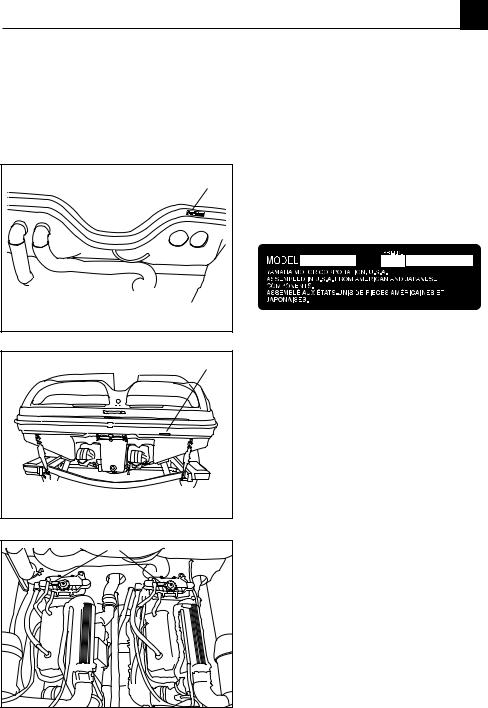
SAFETY INFORMATION 1
1
2 |
3 |
IDENTIFICATION
NUMBER RECORDS
Record your Primary I.D., H.I.N., and engine numbers in the spaces provided to assist you in ordering spare parts from your Yamaha Boat dealer. Also record and keep these I.D. numbers in a separate place in case your boat is stolen.
PRIMARY I.D. NUMBER
F1UC
\ |
\ |
\ |
\ |
\ |
\ |
\ |
\ |
\ |
\ |
\ |
The Primary I.D. number is stamped on a label 1 attached to the inside of the engine compartment.
HULL IDENTIFICATION NUMBER (H.I.N.)
\ |
\ |
\ |
\ |
\ |
\ |
\ |
\ |
\ |
\ |
\ |
\ |
The H.I.N. 2 is stamped into the hull on the right rear corner.
ENGINE SERIAL NUMBER
PORT
\ |
\ |
\ |
\ |
|
|
|
\ |
\ |
\ |
\ |
\ |
\ |
|
||
|
|
|
|||||||||||||
|
|
|
|
|
|
|
|
|
|
|
|
|
|
|
|
STARBOARD |
|
|
|
|
|
|
|
||||||||
|
|
|
|
|
|
|
|
|
|
|
|
|
|
|
|
\ |
\ |
\ |
\ |
|
|
|
|
\ |
\ |
\ |
\ |
\ |
\ |
|
|
|
|
|
|
|
|||||||||||
|
|
|
|
|
|
|
|
|
|
|
|
|
|
|
|
The Engine Serial Numbers are stamped on a label attached to the top of each engine’s oil tank.
1-1
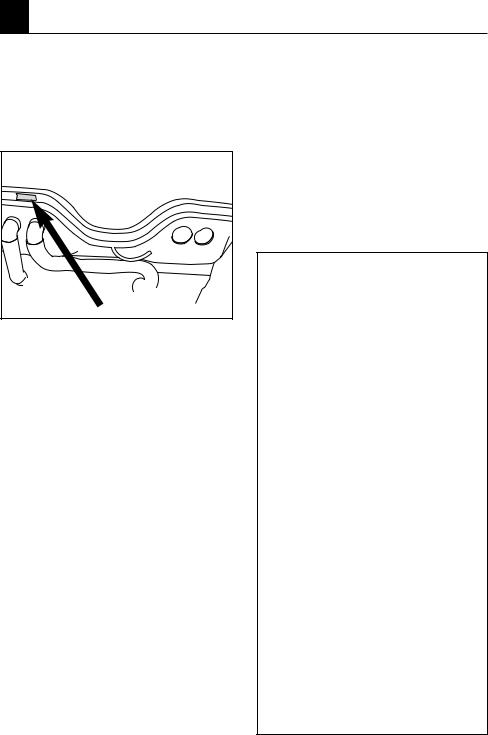
1 SAFETY INFORMATION
STAR LABELS
This watercraft is labeled in California with a California Air Resources Board (CARB) star label 1. See below for a desciption of your particular label.
1 |
ONE STAR - LOW EMISSION
The one-star label identifies engines that meet the Air Resources Board’s 2001 exhaust emission standards. Engines meeting these standards have 75% lower emissions than conventional carbureted two-stroke engines. These engines are equivalent to the U.S. EPA’s 2006 standards for marine engines.
TWO STARS - VERY LOW EMISSION
The two-star label identifies engines that meet the Air Resources Board’s 2004 exhaust emission standards. Engines meeting these standards have 20% lower emissions that One Star- Low-Emission engines.
THREE STARS - ULTRA LOW EMISSION
The three-star label identifies engines that meet the Air Resources Board’s 2008 exhaust emission standards. Engines meeting these standards have 65% lower emissions than One Star- Low-Emission engines.
FOUR STARS -
SUPER ULTRA LOW EMISSION
The four-star label identifies engines that meet the Air Resources Board’s Sterndrive and Inboard marine engine 2009 exhaust emission standards. Personal Watercraft and Outboard marine engines may also comply with these standards. Engines meeting these standards have 90% lower emissions than One Star - Low Emission engines.
1-2

SAFETY INFORMATION 1
1 |
2 |
EMISSION CONTROL
INFORMATION
This engine family conforms to U.S. EPA regulations for marine SI engines.
APPROVAL LABEL OF EMISSION CONTROL CERTIFICATE
This label is attached to the electrical box.
1Emission control information label
EMISSION CONTROL INFORMATION
ENGINE FAMILY :
THIS ENGINE CONFORMS TO |
U.S. EPA REGULATIONS FOR MARINE S1 ENGINES |
|
||
FELs |
g/low - hr |
|
SPARK PLUG GAP (mm) : |
|
|
|
|
TROLLING SPEED : |
rpm |
YAMAHA MOTOR CO., CO, LTD.
MANUFACTURED DATE LABEL
2 Manufactured date label
YAMAHA
Manufactured:
1-3
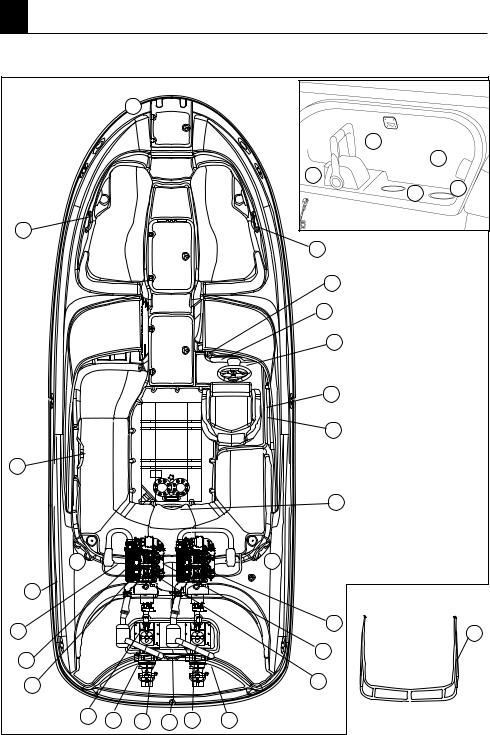
1 SAFETY INFORMATION
IMPORTANT LABELS
|
|
7 |
|
|
|
|
|
|
|
|
|
|
|
2 |
|
|
|
|
|
|
|
|
4 |
|
|
|
|
|
|
1 |
|
|
|
|
|
|
|
3 |
18 |
|
|
|
|
|
|
|
|
6 |
|
|
|
|
|
|
|
|
|
|
|
|
|
6 |
|
|
|
|
|
|
|
15 |
|
|
|
|
|
|
|
5 |
|
|
|
|
|
|
|
21 |
|
|
|
|
|
|
|
16 |
|
|
|
|
|
|
|
18 |
|
6 |
|
|
|
|
|
|
|
|
|
|
|
|
|
8 |
|
6 |
|
|
|
|
|
6 |
|
11 |
|
|
|
|
|
|
|
17 |
|
|
|
|
|
17 |
14 |
|
|
|
|
|
|
||
13 |
|
|
|
|
|
13 |
|
|
|
|
|
|
|
|
|
19 |
|
|
|
|
|
19 |
|
|
|
|
|
|
|
|
|
12 |
7 |
9 |
20 |
10 |
7 |
WAKEBOARD TOWER |
|
|
|
|
|
|
|
1-4 |
|
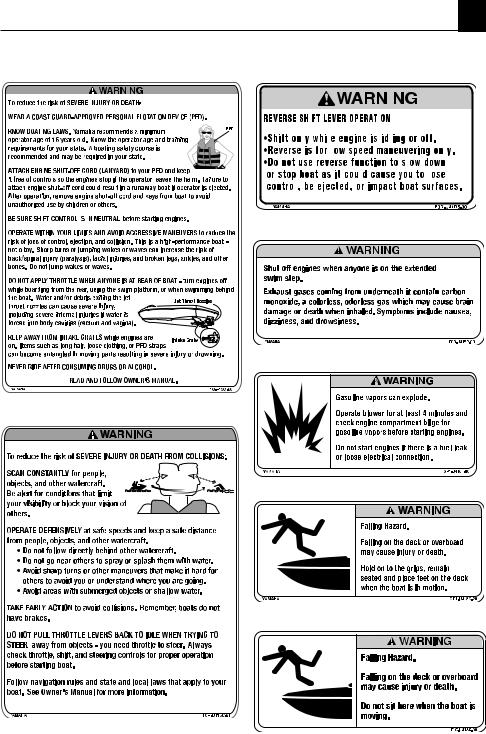
SAFETY INFORMATION 1
WARNING LABELS
1 |
|
|
|
|
|
|
|
|
|
|
|
|
|
|
|
|
|
|
3 |
|
|
|
|
|
|
|
|
|
|
|
|
|
||
|
|
|
|
|
|
|
|
|
|
|
|
|
|
|
|
|
|
|
|
|
|
|
|
|
|
|
|
|
|
|
|
|
|
|
|
|
|
|
|
|
|
|
|
|
|
|
|
|
|
|
|
|
|
|
|
|
|
|
|
|
|
|
|
|
|
|
|
|
|
|
|
|
|
|
|
|
|
|
|
|
|
|
|
|
|
|
|
|
|
|
|
|
|
|
|
|
|
|
|
|
|
|
|
|
|
|
|
|
|
|
|
|
|
|
|
|
|
|
|
|
|
|
|
|
|
|
|
|
|
|
|
|
|
|
|
|
|
|
|
|
|
|
|
|
|
|
|
|
|
|
|
|
|
|
|
|
|
|
|
|
|
|
|
|
|
|
|
|
|
|
|
|
|
|
|
|
|
|
|
|
|
|
|
|
|
|
|
|
|
|
|
|
|
|
|
|
|
|
|
|
|
|
|
|
|
|
|
|
|
|
|
|
|
|
|
|
|
|
|
|
|
|
|
|
|
|
|
|
|
|
|
|
|
|
|
|
|
|
|
|
|
|
|
|
|
|
|
|
|
|
|
|
|
|
|
|
|
|
|
|
|
|
|
|
|
|
|
|
|
|
|
|
|
|
|
|
|
|
|
|
|
|
|
|
|
|
|
|
|
|
|
|
|
|
|
|
|
|
|
|
|
|
|
|
|
|
|
|
|
|
|
|
|
|
|
|
|
|
|
|
|
|
|
|
|
|
|
|
|
|
|
|
|
|
|
|
|
|
|
|
|
|
|
|
|
|
|
|
|
|
|
|
|
|
|
|
|
|
|
|
|
|
|
|
|
|
|
|
|
|
|
|
|
|
|
|
|
|
|
|
|
|
|
|
|
|
|
|
|
|
|
|
|
|
|
|
|
|
|
|
|
|
|
|
|
|
|
|
|
|
|
|
|
|
|
|
|
|
|
|
|
|
|
|
|
|
|
|
|
|
|
|
|
|
|
|
|
|
|
|
|
|
|
|
|
|
|
|
|
|
|
|
|
|
|
|
|
|
|
|
|
|
|
|
|
|
|
|
|
|
|
|
|
|
|
|
|
|
|
|
|
|
|
|
|
|
|
|
|
|
|
|
|
|
|
|
|
|
|
|
|
|
|
|
|
|
|
|
|
|
|
|
|
|
|
|
|
|
|
|
|
|
|
|
|
|
|
|
|
|
|
|
|
|
|
|
|
|
|
|
|
|
|
|
|
|
|
|
|
|
|
|
|
|
|
|
|
|
|
|
|
|
|
|
|
|
|
|
|
|
|
|
|
|
|
|
|
|
|
|
|
|
|
|
|
|
|
|
|
|
|
|
|
|
|
|
|
|
|
|
|
|
|
|
|
|
|
|
|
|
|
|
|
|
|
|
|
|
|
|
|
|
|
|
|
|
|
|
|
|
|
|
|
|
|
|
|
|
|
|
|
|
|
|
|
|
|
|
|
|
|
|
|
|
|
|
|
|
|
|
|
|
|
|
4
5
2
6
7
1-5
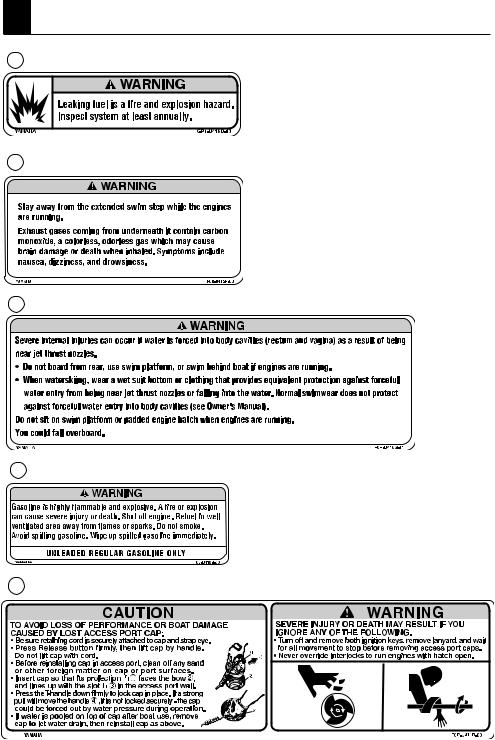
1 SAFETY INFORMATION
8
9
10
11
12
1-6
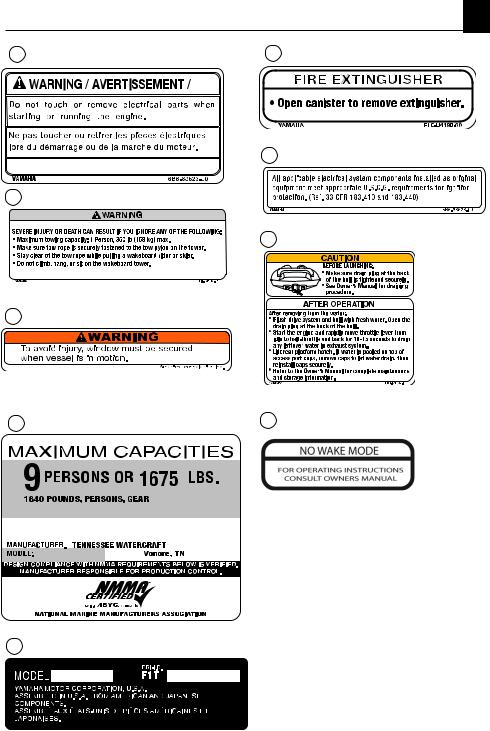
SAFETY INFORMATION 1
13 |
18 |
19
14
20
AR210 MODEL ONLY
15
OTHER LABELS
16 |
21 |
|
17
1-7

1 SAFETY INFORMATION
 SAFETY
SAFETY
INFORMATION
The safe use and operation of this boat is dependent upon the use of proper operating techniques, as well as upon the common sense, good judgment, and expertise of the operator. Every operator should know the following requirements before operating the boat.
Before operating the boat, read the Owner’s/Operator’s Manual, the Operation Instruction Card, and all warning and caution labels on the boat. Also, watch the Basic Orientation Video provided with your boat. These materials should give you an understanding of the boat and its operation.
Never allow anyone to operate this boat until they too have read the Owner’s/Operator’s Manual, the Operation Instruction Card, and all warning and caution labels, and if possible watched the Basic Orientation Video. Showing them the video may help reinforce the information contained in these materials.
LIMITATIONS ON WHO MAY OPERATE THE BOAT
Yamaha recommends a minimum operator age of 16 years old.
Adults must supervise use by minors.
Know the operator age and training requirements for your state. A boating safety course is recommended and may be required in your state. You can find local rules by contacting the United States Coast Guard (USCG), the National Association of State Boating Law Administrators, or your local Power Squadron.
This boat is designed to carry the operator, up to 8 passengers, and cargo. Never exceed the maximum load limit or allow more than 9 persons (or 8 persons if a water skier is being pulled) to ride in the boat at one time. Weight distribution affects performance. Keep weight in the boat low and evenly distributed from side-to-side and front-to-back. Remove any unnecessary cargo and store it on shore.
Maximum Load: 1674 lb. (759 kg) is the maximum total weight of persons on board.
1840 lb. (834 kg) is the maximum total weight of persons and cargo.
1-8

SAFETY INFORMATION 1
REQUIRED EQUIPMENT
The U.S. Coast Guard (USCG) has regulations which describe minimum standards of safety. You must comply with these regulations, which apply to boats like your boat which are less than 26 feet long.
Personal Flotation Devices (PFDs): USCG-approved PFDs worn by all people aboard, plus at least one Type IV (throwable type).
Fire Extinguisher:
At least one B-1 type hand-held portable fire extinguisher.
Visual Distress Signals:
It is recommended that a USCGapproved pyrotechnic device be stored on your boat. A mirror can also be used as an emergency signal. Contact your Yamaha dealer or the Coast Guard for more information.
Sound Signalling Device:
Your boat is equipped with a horn that can be used to signal other boats. See “Rules of the Road” for more information.
Navigation Lights:
Your boat is equipped with navigation lights for use between sunset and sunrise, and during periods of reduced visibility, such as fog. Be sure these lights are working and are turned on when necessary (see page 2-14 and 3-9 for more information).
ADDITIONAL EQUIPMENT RECOMMENDATIONS
The following equipment can help make your boating experience safer and more enjoyable:
Mooring fenders and lines.
Anchor with suitable line (a “Danforth” type anchor and line that is at least 6-times the depth of the water where you will drop anchor are recommended).
Manual-type bilge pump.
First Aid kit.
Waterproof flashlight with extra batteries.
Tool kit with assorted screwdrivers, pliers, wrenches (including metric sizes), and electrical tape.
Oar or paddle (look for one with a boat hook on the other end).
Spare parts, such as an extra set of spark plugs and fuses.
Navigation charts for the waters where you will be boating.
Tow rope.
1-9
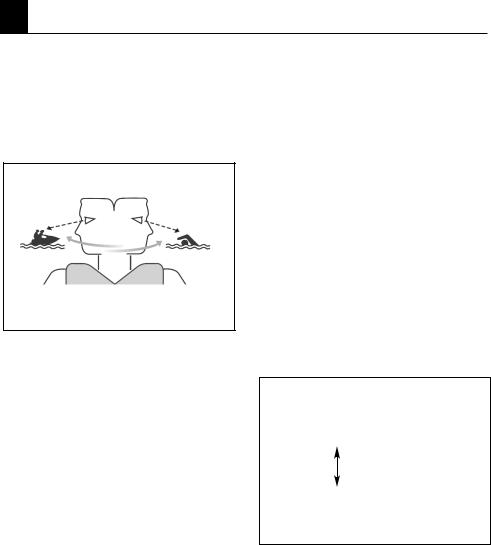
1 SAFETY INFORMATION
CRUISING LIMITATIONS
Scan constantly for people, objects, and other watercraft. Be alert for conditions that limit your visibility or block your vision of others.
Operate defensively at safe speeds and keep a safe distance from people, objects, and other watercraft.
Do not follow directly behind other boats.
Do not go near others to spray or splash them with water.
Avoid sharp turns or other maneuvers that make it hard for others to avoid you or understand where you are going.
Avoid areas with submerged objects or shallow water.
Operate within your limits and avoid aggressive maneuvers to reduce the risk of loss of control, ejection, and collision.
This is a high-performance boat – not a toy. Sharp turns or jumping waves or wakes can increase the
risk of back/spinal injury (paralysis), facial injuries, and broken legs, ankles, and other bones. Do not jump waves or wakes.
Do not operate the boat in rough water, bad weather, or when visibility is poor; this may lead to an accident causing injury or death. Be alert to the possibility of bad weather. Take note of weather forecasts and the prevailing weather conditions before setting out in your boat.
Never operate in water that is less than 3 ft. (90 cm) deep, otherwise you increase your chance of hitting a submerged object, which could result in injury.
3 FT (90 CM)
Leave a “float plan” with a responsible person on shore. Tell where you plan to go and when you plan to arrive, and provide a description of your boat. Advise this person if your plans change and also when you arrive to prevent false alarms. A sample float plan is included on page 6-6.
1-10

SAFETY INFORMATION 1
OPERATIONAL REQUIREMENTS
All riders must wear a Coast Guard approved personal flotation device (PFD).
PFD
Eye protection is recommended to keep wind, water, and glare from the sun out of your eyes while you operate your boat. Restraining straps for eyewear are made which are designed to float should your eyewear fall into the water.
Footwear and gloves are recommended.
NEVER operate the boat after consuming alcohol or taking drugs.
For reasons of safety and proper care of the boat, always perform the pre-operation checks listed on page 3-4 before operating.
Passengers must always sit in a designated seating area, place feet on the deck, and hold on to the hand grips when the boat is in motion.
Always consult your doctor on whether it is safe for you to ride in this boat if you are pregnant or in poor health.
Do not attempt to modify this boat! Modifications to your boat may reduce safety and reliability, and render the boat unsafe or illegal to use.
1-11
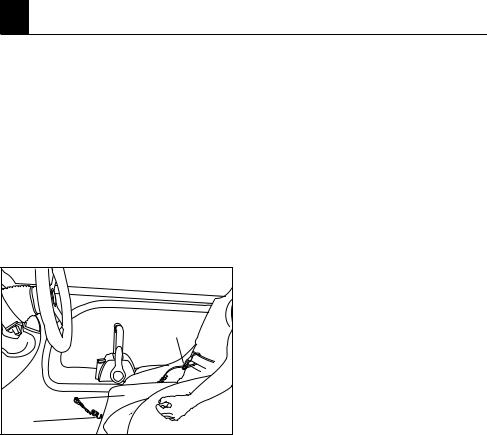
1 SAFETY INFORMATION
Attach the engine shut-off cord (lanyard) to the PFD and keep it free from the steering wheel or other controls so that the engine stops if the operator accidentally leaves the helm. Failure to attach the engine shut-off cord could result in a runaway boat if the operator is ejected.
After operation, remove the engine shut-off cord and the keys to avoid accidental starting or unauthorized use by children or others.
3 |
1 |
2 |
1 Engine Shut-Off Switch |
2 Engine Shut-Off Cord with Clip |
3 Cord connected to PFD |
Scan constantly for swimmers and stay away from swimming areas. Swimmers are hard to see and you could accidentally hit someone in the water.
Avoid being hit by another boat! You should always take responsibility to watch for other traffic; other boaters may not be watching for you. If they do not see you, or you maneuver more quickly than they expect, you risk a collision.
Maintain a safe distance from other boats or watercraft, and also watch for boats’ ski ropes or fishing lines. Obey the “Rules of the Road” (see page 1-15), and be sure to check behind you before making a turn.
HAZARD INFORMATION
Never start the engine or let it run for any length of time in an enclosed area. Exhaust fumes contain carbon monoxide, a colorless, odorless gas that may cause death within a short time. Always operate the boat in an open area.
It is also important to have the engines off when anyone is using the extended swim step on models equipped with one because of the carbon monoxide in the exhaust gases coming from underneath the step.
BOAT CHARACTERISTICS
Jet thrust turns the boat. Moving the throttle levers completely back to idle or the Neutral position produces only minimum thrust. If you are traveling at speeds above trolling, you will have rapidly decreasing ability to steer without throttle. You may still have some turning ability immediately after moving the throttle levers back to idle, but once the engines slow down, the boat will no longer respond to steering wheel input until you apply throttle again or you reach a trolling speed. Practice turning in
1-12
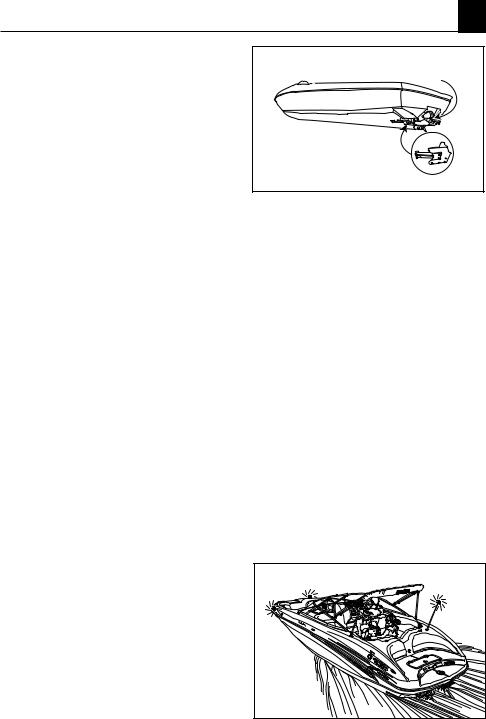
SAFETY INFORMATION 1
an open area without obstructions until you have a good feel for the maneuver.
This Yamaha Boat is water-jet propelled. The pumps are directly connected to the engines. This means that the jet thrust will produce some movement whenever the engines are running. The boat has a “neutral” position, but since the boat is always producing thrust while the engines are running, some forward or reverse movement may occur.
Do not use the reverse function to slow down or stop the boat as it could cause you to lose control, be ejected, or impact the steering wheel or other parts of the boat. This could increase the risk of serious injury. It could also damage the shift mechanism.
JET THRUST NOZZLES
INTAKE GRATE
Stop the engines and remove the clip from the engine shut-off switch before removing any debris or weeds, which may have collected around the jet intakes.
Never insert any object into the jet thrust nozzle while the engine is running. Severe injury or death could result from coming in contact with the rotating parts of the jet pump.
Reverse can be used to slow down or stop during slow speed maneuvering, such as when docking. Once the engine is idling, shift to reverse and gradually increase engine speed. Make sure that there are no obstacles or people behind you before shifting into reverse.
Keep away from the intake grates while the engine is on. Items such as long hair, loose clothing, or PFD straps can become entangled in moving parts, resulting in severe injury or drowning.
NIGHT OPERATION
When using your boat before dawn or after dusk, you must have both bow and stern lights operating. When at anchor in the dark, the stern light must be lit. See page 2-14 for instructions.
1-13 |
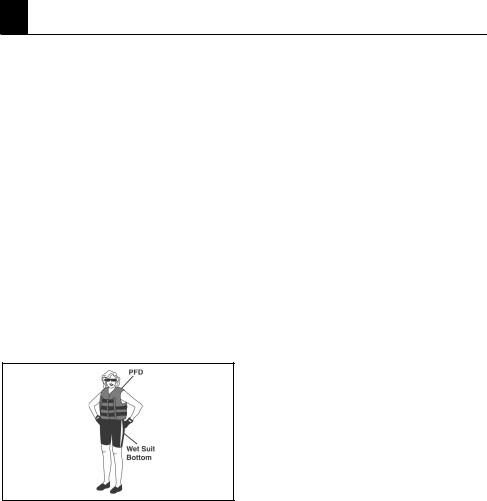
1 SAFETY INFORMATION
WATER-SKIING
You can use the boat to tow a water skier, using the tow cleat provided.
It is the boat operator’s responsibility to be alert to the safety of the water-skier and others. Know and follow all state and local water-skiing regulations in effect for the waters in which you will be operating.
The following are some important considerations for minimizing risks while water-skiing.
The skier should wear an approved PFD, preferably a brightly colored one so boat operators can see the skier.
The skier should wear protective clothing. Severe internal injuries can occur if water is forced into body cavities as a result of falling into the water or while reboarding. Normal swimwear does not adequately protect against forceful water entry into rectum or vagina. The skier should wear a wetsuit bottom or clothing that provides equivalent protection. Such clothing includes thick, tightly woven, sturdy, and snug fitting
apparel such as denim, but does not include spandex or similar fabrics like those used in bicycle shorts.
A second person should be on board as a spotter to watch the skier; in most states, it is required by law. Let the skier direct the operator’s control of speed and direction with hand signals.
When preparing to pull a skier, operate the boat at the slowest possible speed until the boat is well away from the skier and slack in the towrope is taken up. Make sure that the rope is not looped around anything.
After checking that the skier is ready and that there is no traffic or other obstacles, apply enough throttle to raise the skier.
Make smooth, wide turns. The boat is capable of very sharp turns, which could exceed the abilities of the skier. Keep the skier at least 50m (164 ft), about twice the distance of a standard towrope, away from any potential hazard.
Be alert to the hazard of the towrope handle snapping back at the boat when the skier falls or is unable to get up on the skis.
For the AR210, also see page 2-20 for Wakeboard Tower use.
1-14

SAFETY INFORMATION 1
RULES OF THE ROAD
Your Yamaha Boat is legally considered a powerboat. Operation of the boat must be in accordance with the rules and regulations governing the waterway on which it is used.
Just as there are rules that apply when you are driving on streets and highways, there are waterway rules that apply when you are operating your boat. These rules are used internationally, and are also enforced by the United States Coast Guard and local agencies.You should be aware of these rules, and follow them whenever you encounter another vessel on the water.
Several sets of rules prevail according to geographic location, but are all basically the same as the International Rules of the Road. The rules presented here in this Owner’s/Operator’s Manual are condensed, and have been provided for your convenience only. Consult your local U.S. Coast Guard Auxiliary or Department of Motor Vehicles for a complete set of rules governing the waters in which you will be operating your boat.
STEERING AND SAILING RULES
Whenever two vessels on the water meet one another, one vessel has the right-of-way; it is called the “stand-on” vessel. The vessel that does not have the right-of-way is called the “give-way” or “burdened” vessel. These rules determine which vessel has the right- of-way, and what each vessel should do.
Stand-On Vessel
The vessel with the right-of-way has the duty to continue its course and speed, except to avoid an immediate collision. When you maintain your direction and speed, the other vessel will be able to determine how best to avoid you.
Give-Way Vessel
The vessel which does not have the right-of-way has the duty to take positive and timely action to stay out of the way of the stand-on vessel. Normally, you should not cross in front of the vessel with the right-of-way. You should slow down or change directions briefly and pass behind the other vessel. You should always move in such a way that the operator of the other vessel can see what you are doing.
The General Prudential Rule regarding the right-of-way is that if a collision appears unavoidable, neither boat has the right-of-way. Both boats must avoid the collision.
In other words, follow the standard rules except when a collision will occur unless both vessels try to avoid each other. If that is the case, both vessels become give-way vessels.
1-15
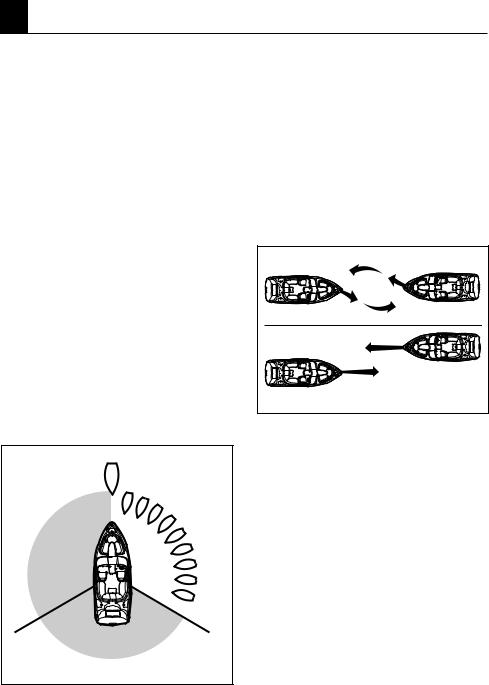
1 SAFETY INFORMATION
RULES WHEN ENCOUNTERING VESSELS
There are three main situations that you may encounter with other vessels which could lead to a collision unless the Steering Rules are followed:
Meeting: you are approaching another vessel head-on.
Crossing: you are traveling across another vessel’s path.
Meeting
If you are meeting another power vessel head on, and are close enough to run the risk of collision, neither of you has the right-of-way! Both of you should alter course to avoid an accident. You should keep the other vessel on your port (left) side. This rule does not apply if both of you will clear one another if you continue on your set course and speed.
Overtaking: you are passing or being passed by another vessel.
In the following illustration, your boat is in the center. You should give the right- of-way to any vessels shown in the white area (you are the give-way vessel). Any vessels in the shaded area must yield to you (they are the give-way vessels). Both you and the meeting vessel must alter course to avoid each other.
1-16 |
Crossing
When two power-driven vessels are crossing each other’s path close enough to run the risk of collision, the vessel which has the other on the starboard (right) side must keep out of the way of the other. If the other vessel is on your starboard (right) side, you must keep out of its way; you are the giveway vessel. If the other vessel is on your port (left) side, remember that you should maintain course and direction, provided the other vessel gives you the right-of-way, as it should.

SAFETY INFORMATION 1
Overtaking
If you are passing another vessel, you are the give-way vessel. This means that the other vessel is expected to maintain its course and speed. You must stay out of its way until you are clear of it. Likewise, if another vessel is passing you, you should maintain your speed and direction so that the other vessel can steer itself around you.
GIVE-WAY
GIVE-WAY
VESSEL
VESSEL
OTHER SPECIAL SITUATIONS
There are three other rules you should be aware of when operating your boat around other vessels.
Narrow Channels and Bends
When navigating in narrow channels, you should keep to the right when it is safe and practical to do so. If the operator of a power-driven vessel is preparing to go around a bend that may obstruct the view of other water vessels, the operator should sound a prolonged blast of four to six seconds on the horn. If another vessel is around the bend, it too should sound the horn. Even if no reply is heard, however, the vessel should still proceed around the bend with caution.
Fishing Vessel Right-of-Way
All vessels fishing with nets, lines or trawls are considered to be “fishing vessels” under the International Rules. Vessels with trolling lines are not considered fishing vessels. Fishing vessels have the right-of-way regardless of position. Fishing vessels cannot, however, impede the passage of other vessels in narrow channels.
Sailing Vessel Right-of-Way
Sailing vessels should normally be given the right-of-way. The exceptions to this are:
1.When the sailing vessel is overtaking the power-driven vessel, the power-driven vessel has the right- of-way.
2.Sailing vessels should keep clear of any fishing vessel.
3.In a narrow channel, a sailing vessel should not hamper the safe passage of a power-driven vessel that can navigate only in such a channel.
1-17
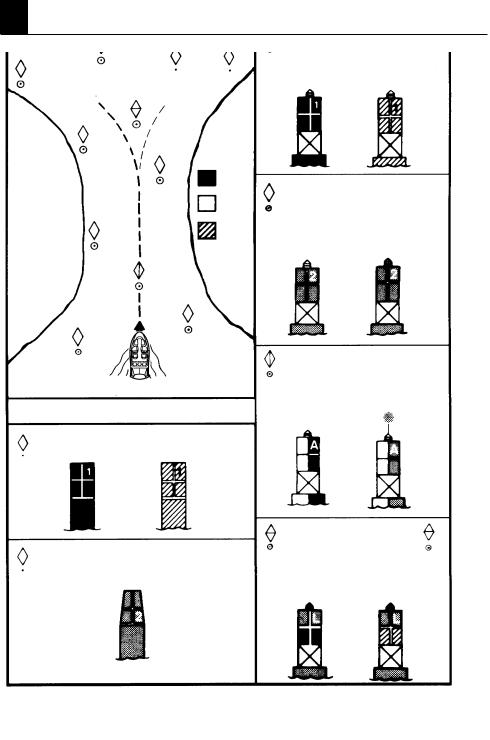
1 SAFETY INFORMATION
“7”
MAIN |
CHANNEL |
|
“6”
RB “L” or RG “L”
CHANNEL |
|
C “1” |
N “2” |
|
|
SECONDARY |
|
“5”
“4”
“1” “3” “5” “7”
LIGHTED BUOY (Port Hand)
Odd number, increasing toward head of navigation. Leave to port (left) proceeding
White Light |
Green Light |
|
OR |
Old |
New |
“3”
“A”
“2”
“1”
toward head of from seaward
SECONDARY CHANNEL BUOYS
STARTS NEW NUMBERING SYSTEM
C “1”
CAN BUOY
Odd number. Leave to port.
OR
Old |
New |
N “2”
NUN BUOY
Even number. Leave to starboard.
No change
“2” “4” “6”
LIGHTED BUOY (Starboard Hand) Even number, increasing toward head of navigation. Leave to starboard (right) proceeding up-stream
White Light |
Green Light |
|
OR |
Old |
New |
“A”
LIGHTED SAFE WATER BUOY
No number. Marks midchannel, pass on either side. Letter has no lateral significance, used for identification and
location purposes. |
|
|
Top Mark |
White Light |
Green Light |
|
OR |
Old |
New |
RB “L” |
RB “L” |
LIGHTED PREFERRED
CHANNEL TO PORT BUOY
No number. Topmost band red - preferred channel is to left of buoy. Letter has no lateral significance, used for identification and location purposes.
Red or |
Red |
White Light |
Light |
OR |
|
Old |
New |
1-18

SAFETY INFORMATION 1
Reading Buoys and Other Markers
The waters of the United States are marked for safe navigation by the lateral system of buoyage. Simply put, buoys and markers have an arrangement of shapes, colors, numbers, and lights to show which side of the buoy a boater should pass on when navigating in a particular direction. The markings on these buoys are oriented from the perspective of being entered from seaward (the boater is going towards the harbor). Red buoys are passed on your starboard (right) side when proceeding from open water into port, and black buoys are to your port (left) side. An easy way to remember the meaning of the colors is the phrase “red right returning.” When navigating out of the harbor, your position with respect to the buoys should be reversed; red buoys should be to port and black buoys to starboard.
Many bodies of water used by boaters are entirely within the boundaries of a particular state. The Uniform State Waterway Marking System has been devised for these waters.
This system uses buoys and signs with distinctive shapes and colors to show regulatory or advisory information. These markers are white with black letters and orange borders. They signify speed zones, restricted areas, danger areas, and general information.
Remember, markings may vary by geographic location. Always consult local boating authorities before riding your boat in unfamiliar waters.
TO GET MORE BOATING SAFETY INFORMATION
Be informed about boating safety. Additional publications and information can be obtained from many organizations, including the following.
United States Coast Guard
Consumer Affairs Staff (G-BC)
Office of Boating, Public, and
Consumer Affairs
US Coast Guard Headquarters
Washington, D.C. 20593-0001
Boating Safety Hotline:
1-800-368-5647
Other Sources:
You can find local rules by contacting the National Association of State Boating Law Administrators, or your local Power Squadron.
BOAT EDUCATION AND TRAINING
The Online Boating Safety Course, available through the watercraft section of the yamaha-motor.com website, is a free, 50-question learning course available to the public. Upon successful completion of 80 percent or better, the user can request a certificate of completion by mail or can download one immediately. The Online Boating Safety Course, provided by the Boat/US Foundation, is approved by the National Association of State Boating Law Administrators (NASBLA) and recognized by the United States Coast Guard. This course meets the education requirement for those states that recognize non-proctored, NASBLAapproved courses.
1-19

1 SAFETY INFORMATION
ENJOY YOUR BOAT RESPONSIBLY
You share the areas you enjoy when operating your boat with others and with nature. So your enjoyment includes a responsibility to treat these other people, and the lands, waters, and wildlife with respect and courtesy.
Whenever and wherever you are boating, think of yourself as the guest of those around you. Remember, for example, that the sound of your boat may be music to you, but it could be just noise to others. And the exciting splash of your wake can make waves others won't enjoy. Avoid riding close to shoreline homes and waterfowl nesting areas or other wildlife areas, and keep a respectful distance from fishermen, other boats, swimmers, and populated beaches. When travel in areas like these is unavoidable, operate slowly and obey all laws.
Remember that pollution can be harmful to the environment. Do not refuel or add oil where a spill could cause damage to nature. And keep your surroundings pleasant for the people and wildlife that share the waterways: don't litter!
When you go boating responsibly, with respect and courtesy for others, you help ensure that our waterways stay open for the enjoyment of a variety of recreational opportunities.
1-20

Chapter 2
FEATURES & FUNCTIONS
LOCATION OF MAIN COMPONENTS . . . . . . . . . . . . . . . . . . . . . . . . . . . . . 2-1
OPERATION OF CONTROLS AND OTHER FUNCTIONS . . . . . . . . . . . . . . 2-5
Steering . . . . . . . . . . . . . . . . . . . . . . . . . . . . . . . . . . . . . . . . . . . . . . . . 2-5
Tilt Lever . . . . . . . . . . . . . . . . . . . . . . . . . . . . . . . . . . . . . . . . . . . . . . . . 2-5
Engine Shut-Off Switch . . . . . . . . . . . . . . . . . . . . . . . . . . . . . . . . . . . . 2-6
Main Switches . . . . . . . . . . . . . . . . . . . . . . . . . . . . . . . . . . . . . . . . . . . . 2-6
Throttle/Shift Levers . . . . . . . . . . . . . . . . . . . . . . . . . . . . . . . . . . . . . . . 2-7
Fuel Tank Filler Cap . . . . . . . . . . . . . . . . . . . . . . . . . . . . . . . . . . . . . . . 2-9
Gauges . . . . . . . . . . . . . . . . . . . . . . . . . . . . . . . . . . . . . . . . . . . . . . . . . 2-9
Overheat Warning System . . . . . . . . . . . . . . . . . . . . . . . . . . . . . . . . . 2-13
Switches . . . . . . . . . . . . . . . . . . . . . . . . . . . . . . . . . . . . . . . . . . . . . . . 2-14
Swivel Seat Operation . . . . . . . . . . . . . . . . . . . . . . . . . . . . . . . . . . . . 2-16
Stereo System . . . . . . . . . . . . . . . . . . . . . . . . . . . . . . . . . . . . . . . . . . 2-16
Engine Hood . . . . . . . . . . . . . . . . . . . . . . . . . . . . . . . . . . . . . . . . . . . . 2-17
Storage Compartments . . . . . . . . . . . . . . . . . . . . . . . . . . . . . . . . . . . 2-17
Front Walk-Through . . . . . . . . . . . . . . . . . . . . . . . . . . . . . . . . . . . . . . 2-19
Rear Walk-Through . . . . . . . . . . . . . . . . . . . . . . . . . . . . . . . . . . . . . . . 2-20
Swim Platform . . . . . . . . . . . . . . . . . . . . . . . . . . . . . . . . . . . . . . . . . . . 2-20
Wakeboard Tower . . . . . . . . . . . . . . . . . . . . . . . . . . . . . . . . . . . . . . . . 2-20

|
|
|
FEATURES & FUNCTIONS 2 |
||
|
LOCATION OF MAIN COMPONENTS |
||||
|
|
|
|
1 |
|
|
2 |
|
|
12 |
|
|
|
12 |
|
||
|
|
|
|
||
|
|
|
10 |
|
|
|
4 |
|
|
4 |
|
|
|
|
|
||
|
11 |
|
|
11 |
|
|
|
|
|
||
|
13 |
3 |
|
3 |
|
|
|
|
|
||
|
|
|
5 |
5 |
|
|
|
13 |
|
6 |
|
|
6 |
|
|
||
|
|
|
7 |
||
|
|
|
|
||
|
7 |
|
17 |
17 |
|
|
|
|
|||
|
8 |
|
|
|
|
|
9 |
|
|
|
|
|
|
18 |
|
18 |
|
|
|
19 |
|
19 |
|
Main Features: |
|
11 |
Air Filter Cases |
||
1 |
Fuel Tank |
|
12 |
Hood Supports |
|
2 |
Battery |
|
13 |
Engine Compartment Vent Outlets |
|
3 |
Blower Motor |
|
14 |
Engine Compartment Vent Inlets |
|
Port/Starboard Features: |
15 |
Fuel Tank Compartment Air Ventilation |
|||
16 |
Fuel Tank Compartment Drain Plug |
||||
4 |
Flush Attachments |
|
|||
|
17 |
Jet Pumps |
|||
5 |
Electrical Boxes |
|
|||
|
18 |
Jet Thrust Nozzles |
|||
6 |
Oil Tanks |
|
|||
|
19 |
Reverse Gate |
|||
7 |
Oil Tank Cap/ Dipstick |
||||
|
|
||||
8 |
Mufflers |
|
|
|
|
9 |
Muffler Boxes |
|
|
|
|
10 Spark Plugs/ Spark Plug Caps |
|
|
|||
|
|
|
2-1 |
|
|

2 FEATURES & FUNCTIONS |
|
||
4 |
2 |
24 |
|
|
|||
|
|
||
1 |
3 |
1 |
|
|
|||
|
|
||
6 |
|
6 |
|
|
|
||
B |
|
B |
|
|
5 |
||
5 |
|
||
|
|
||
3 |
3 |
3 |
|
|
|
20 |
|
19 |
3 |
C |
|
|
|
3 |
|
3 |
|
|
|
|
10 |
9 |
|
|
|
||
|
|
6 |
|
6 |
|
|
|
|
17 |
18 |
|
3 |
8 |
22 |
|
|
|||
5 |
3 |
||
|
|||
|
21 |
|
|
5 |
|
5 |
|
|
|
12 |
|
B |
|
B |
|
|
|
A |
|
14 |
15 |
6 |
|
6 |
|
|
|
17 |
|
13 |
|
|
|
||
|
23 |
16 |
|
|
|
||
|
2-2 |
|
|

FEATURES & FUNCTIONS 2
LOCATION OF MAIN COMPONENTS:
1Bow Lights
2Bow Eye
3Storage Compartments
4Bow Anchor Locker
5Grab Handles
6Cleats
7 Courtesy Lights
8Fuel Tank Inspection Access Hatch
9Throttle/Shift Levers
10Cooler
11Stern Light Storage
12Stern Light Socket
13Ski Tow Hook
14Jet Pump Clean-out Access Panel
15Pump Clean-out Interlock Switches
16Rear Boarding Step
17Accessory Pedestal Table Mounts
18Tilt Adjustable Steering Wheel
19Glove Box
20Center Walk-Through
21Walk-Through Transom
22Fire Extinguisher Holder
23Stern Ladder
24Bow Ladder
Wakeboard Tower (AR210 ONLY, not shown)
LOCATION OF STEREO COMPONENTS:
A Remote Control Keypad (AR and SX MODEL ONLY)
B Speakers
C CD Player/Receiver
2-3
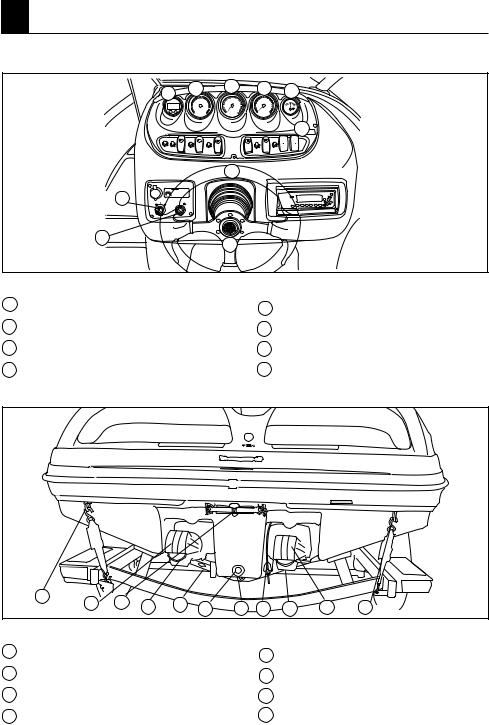
2 FEATURES & FUNCTIONS
LOCATION OF MAIN COMPONENTS
3 2
|
4 |
5 |
|
2 |
3 RPM |
6 |
|
|
x 1000 |
|
|
1 8
0 9
YAMAHA
PORT 5
1
40 45 |
||
35 MPH 50 |
||
30 |
55 |
|
20 |
||
60 |
||
10 |
||
YAMAHA
6
STARBOARD
5
7
Control Features:
1Speedometer
2Tachometer
3Depth Finder
4 Fuel Gauge
2 4
|
4 |
5 |
|
|
3 RPM 6 |
|
|
||
2 |
x 1000 7 |
e |
f |
|
|
|
8 |
||
0 |
|
9 |
|
Fuel |
|
YAMAHA |
|
|
|
8
5 Ignition Switch Keys
6Steering Wheel
7Tilt Adjustment Lever
8Switches and Breakers
6 |
5 |
|
8 |
|
|
|
|
|
|
4 |
3 |
7 |
1 |
2 |
3 |
4 |
6 |
||
|
|
|
Control Features:
1 |
Hull Drain |
5 |
Ladder |
|
|||
2 |
Speedometer Pick-up |
6 |
Trailer Strap Eyes |
3 |
Steering Nozzle |
7 |
Deck Drain |
4 |
Reverse Gates |
8 |
Depth Finder Transponder |
|
|
2-4 |
|
